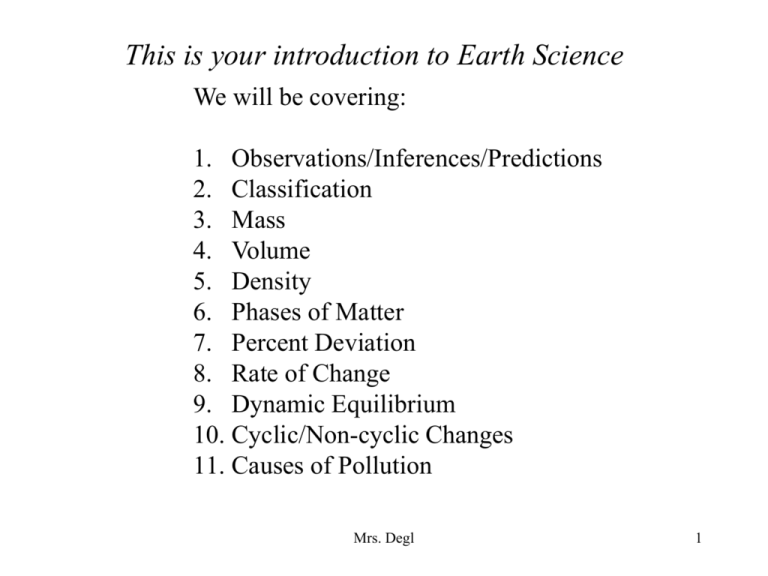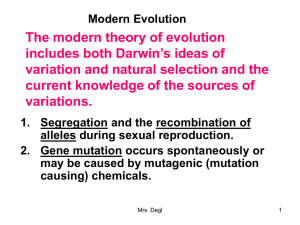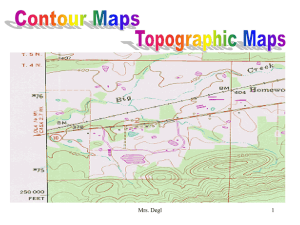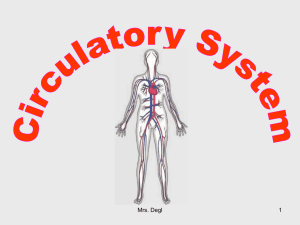The Prologue
advertisement

This is your introduction to Earth Science We will be covering: 1. Observations/Inferences/Predictions 2. Classification 3. Mass 4. Volume 5. Density 6. Phases of Matter 7. Percent Deviation 8. Rate of Change 9. Dynamic Equilibrium 10. Cyclic/Non-cyclic Changes 11. Causes of Pollution Mrs. Degl 1 Observation The interaction of your senses with the environment Examples: 1. The wall is white. 2. The rock is round. 3. The wind is blowing from the south. This is something that you see, smell, taste, hear, touch, or measure. Mrs. Degl 2 Inference A conclusion based on observations. An educated guess. Examples: 1. My bus driver is 59 years old. 2. The river is high because it rained up stream. 3. The sun will be out tomorrow. If you have to think, you make an inference. Mrs. Degl 3 Prediction An inference that indicates what will happen in the future. Examples: 1. It will rain tomorrow. 2. I will pass this class. Mrs. Degl 4 Classification The grouping together of objects or events on the basis of what they have in common. Example: Putting students of similar age in the same grade. Scientists classify for 3 reasons: 1. To organize observations in a meaningful way. 2. To put things in order. 3. The see if relationships exist between things. Mrs. Degl 5 Measurement A means of expressing an observation with great precision. All measurements involve a quantity (number) and at least one unit. Basic Units •A number and one unit. •Length = m,inch,mile,km •Mass = gram,pound •Temperature = degrees C or F Derived Units •A combo of 2 or more units •Velocity = m/hr, km/sec, m/sec •Density = g/cc Mrs. Degl 6 Density The concentration of matter in an object. How packed the molecules in an object are. Sort of “how heavy a object is” NOT VERY DENSE VERY DENSE Mrs. Degl 7 Volume The amount of space an object takes up. Which object has the most volume? Mrs. Degl 8 Mass The amount of matter in an object. We measure mass on a balance!!!!!!!!!!!!!!!!!! Weight and mass are different. Weight is the pull of gravity on mass. Mass units are grams. Mrs. Degl 9 Back to density… D=M/V Size does not effect density!!!!! Two objects made of the same thing have the same density!!!!! Memorize it!!! Mrs. Degl 10 Back to Volume… Volume of a rectangular object: V = Length x Width x Height Volume of a cube: V = side x side x side These both share units of centimeters cubed or cc’s. Volume of a liquid: The volume of a liquid is measured from a graduated cylinder. The units are milliliters (ml). This is just like cc’s. Mrs. Degl 11 Phases of Matter MOST DENSE PHASE LEAST DENSE PHASE This is true for all earth materials, except water!!!! Mrs. Degl 12 Ice (solid water) floats in liquid water!!!!!!!!! Mrs. Degl 13 Solid water is actually LESS DENSE than liquid water. Every other substance on earth is different. Why are these dangerous to ships even if they are not very close? Mrs. Degl 14 Percent Deviation or Percent Error The percent deviation formula is very useful in determining the accuracy of student data. The accepted value is always the correct value. Mrs. Degl 15 Rate of Change The rate of change formula helps us calculate the amount of change over a certain period of time. The slope is the average rate of change of a line. ROC = change in field value time The Field Value is always your Y value on a graph. Mrs. Degl 16 Dynamic Equilibrium A dynamic equilibrium occurs when two reversible processes occur at the same rate. When there is a balance between two opposite reactions, we call that kind of balance a dynamic equilibrium -- equilibrium because there is a balance, dynamic because there are changes taking place. An example of the process can be imagined if a bucket is filled with water and placed in a small room. The water from the bucket will evaporate, and the air in the room will start to become saturated with water vapor. Eventually, the air will be completely saturated with water, and the level of water in the bucket will stop falling. However, water from the bucket is still evaporating. What is happening is that molecules of water in the air will occasionally hit the surface of the water and condense back into the liquid water, and this occurs at the same rate at which water evaporates from the bucket. This is an example of dynamic equilibrium, because the rate of evaporation equals the rate of condensation. Mrs. Degl 17 Cyclic Changes A change that repeats at regular intervals Non-Cyclic Changes A change that does not repeat itself at regular intervals Cannot be predicted at the exact moment A pattern is formed It is predictable 1. Lightning 2. Earthquakes 3. Meteor Impacts 1. Moon Phases 2. Tides 3. Seasons Mrs. Degl 18 Environmental Change Pollution of the environment occurs when the concentration of a substance or form of energy becomes high enough to adversely affect people, their property, or plant/animal life. Pollutants are found in the land, in the air and in the water. Pollution is greatest in highly populated or highly industrialized areas. Pollutants may be solids, liquids, gases, biologic organisms, or forms of energy (heat, sound, and nuclear radiation). Mrs. Degl 19








